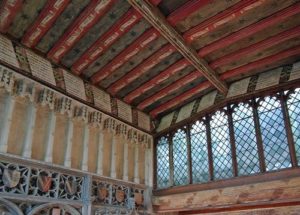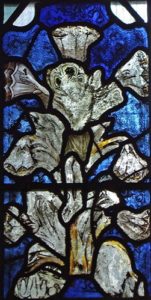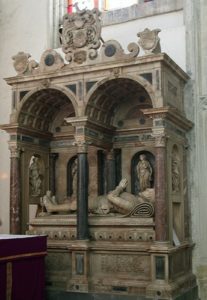Holy Trinity Church has been described as a 'treasure house of English Medieval art'.
It was built in the 15thC on an earlier foundation by John Clopton of Kentwell Hall. The tower was built in 1903 built. The original tower had been destroyed by lightning and the Georgian brick and plaster replacement was felt to be not in keeping with rest of church. The tower was design by Bodley and built round the Georgian tower.
From the outside it is an impressive building with flushwork tower with battlements and small spires at the corners. There is a long battlemented nave and chancel with lower, heavily buttressed side aisles and south porch. The walls are covered with flint flushwork. This was a wealthy church and it showed. A three gabled Lady Chapel was built onto the end of the chancel and has a pointed tile roof, a bit out of keeping with the rest of the building with its flat roof. The Lady Chapel is completely separate from the rest of the church and reached through a small doorway in the south wall.
Inside it feels a big church. The slender pillars with pointed arches and clerestory windows with clear glass, above give an impression of height. There is a wagon beam roof with carved figures on the base of the beams. Pews are modern.
At the back of the church is the 15thC font with crests carved on the side panels and a splendid crocketed spire lid. There is a hatchment by the south door and a carved wooden Royal Coat of Arms.
The north aisle contains one of the finest collections of late 15thC Medieval glass in the country. The stained glass in the clerestory survived the iconoclasts – it was too high up for them the reach. It has now been reassembled in the north aisle.
This is a roll call of Clopton family members, saints and heraldry. The detail is amazing. The portrait of Elizabeth, Duchess of Norfolk is thought to have been the inspiration for John Tenniel’s drawing of the Duchess for Lewis Carrol’s ‘Alice in Wonderland’. The glass was the highlight of the church for us.
At the end of the north aisle is the Clopton (or Kentwell) Chapel surrounded by a carefully carved parclose screen. This contains the memorial to Sir William Clopton d1446 (father of John) in prayer. This has been newly whitewashed. I appreciate this is what it would have originally looked like but it is rather a surprise. There is a copy of a 15thC Spanish seat from Granada cathedral with the arms of Ferdinand and Isabella, but no explanation why it is here. There are family brasses on the floor.
A doorway leads into the smaller Clopton chantry, where priests would say masses for the dead of the Clopton family. It has a beautifully painted ceiling. Below it, the walls are painted with verses by John Lydgate, the poet monk of Bury St Edmunds. The east window has a Lily Crucifix (rare) depicting Christ on the leaves of a lily against a sky blue background. This is now used for private prayer.
The tomb of John Clopton d1497, founder of the church, stands between the chantry and main chapel. A plain table tomb with no carved effigies, this is used as an Easter sepulchre. The canopy has faded portraits of him and his wife with painted shields on the walls.
Back in the chancel, there is a massive stone reredos above the altar with a carving of the crucifixion. On either side are the Ten Commandments, Creed and Lord’s Prayer. On the wall to the right is the massive tomb of Sir William Cordell, lying in armour and praying. This is set under a double arched canopy with marble pillars. At the top is his coat of arms. On the back walls are four statues watching over him; Prudence, Justice, Temperance and Fortitude. He was a judge and Speaker of house of Commons. His entertainment of Elizabeth I at Melford Hall set a standard for extravagance which others found hard to follow. He donated the Hospital of the Holy and Blessed Trinity almshouses on the green near the church.
On the south side of the chancel is the Martyn Chapel, empty apart from the stone base of an unidentified tomb and an old wooden chest. In the floor are splendid brasses to members of the Martyn family with their wives and children.
The Lady Chapel is completely separate from the rest of the church. There is access through the vestry but this is usually kept locked. Instead, go out of the church and through its south door.
The Lady Chapel is unusual as it contains a central altar with a modern painting behind. This is surrounded by an arcade of pointed arches which form an ambulatory round it. There are empty niches where statues were destroyed in the Reformation. The wooden roof is carved and there are angels at the base of the beams. It has been recently whitewashed, covering the Tudor multiplication tables mentioned in some of the books. On the wall is an old clock.
Simon Jenkin’s in “England’s Thousand Best Churches” gives Long Melford Church 5*. We felt it didn’t quite live up to expectation and were a bit disappointed. The Medieval glass was the highlight. Inside, the building is different with the Clopton and Chapel and Chantry running off each other. The Lady Chapel is definitely different. The church does merit a visit.
There is on street parking round the village green. The church is open 10-5.










